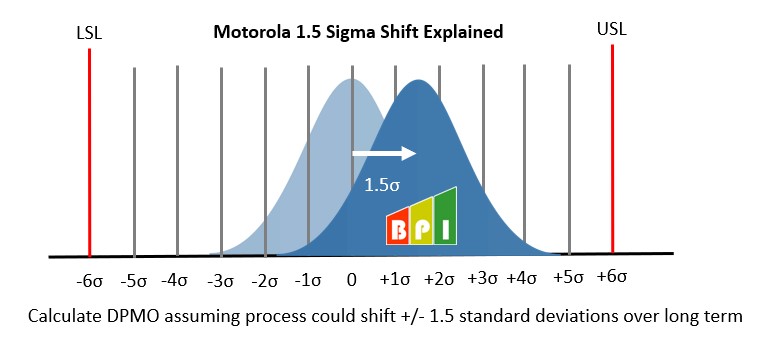Motorola Shift

Motorola determined that processes vary and drift over time based on a long term study of the variation in stacking of discs back in the 1980’s. This variation showed the the process average can shift up to 1.5 standard deviations, and should be factored into the DPMO calculations. However, not all processes will shift this exact amount, but the concept of short term vs long term variation should be understood and accounted for. It is factored into the calculations for Cpk (short term) and Ppk (long term) when performing a capability study.
If you measure the actual performance of a 6 Sigma process, it translates to about 2 defects per billion opportunities (0.002 DPMO). However, the Six Sigma literature says that you will achieve 3.4 DPMO with a 6 sigma process. The difference in these two numbers is based on a 1.5 standard deviation (sigma) shift that is incorporated into the sigma level calculations. In other words, a 6 sigma process should calculate DPMO as a 4.5 sigma process.

This can create confusion in the calculations and interpretation of sigma levels. It is not recommended to focus on the sigma level, but rather improving performance on your primary metric (reducing defects or time delays or customer complaints).
Influences
Influenced
Links
- 1.5 Sigma Process Shift Explanation
- The 1.5 Sigma Shift in Six Sigma
- Where is the evidence for sigma shift?
- Six Sigma Criticisms #1 – The Motorola 1.5 Sigma Shift – Lean Six Sigma Bursts Podcast
Books
- Six Sigma Producibility Analysis and Process Characterization by Mikel J. Harry and J. Ronald Lawson
- Six Sigma: The Breakthrough Management Strategy Revolutionizing the World’s Top Corporations by Mikel Harry and Richard Schroeder
Videos
Additional Resources
- What is DFSS (Six Sigma)?– creativesafetysupply.com
- Motorola’s Six Sigma Program– blog.creativesafetysupply.com
- The History of Six Sigma– lean-news.com
- The Dangers of Shift Work– creativesafetypublishing.com
- Implementing Six Sigma– hiplogic.com
- Design For Six Sigma (DFSS)– iecieeechallenge.org
- Six Sigma and More– blog.5stoday.com
- The Building Blocks of a Lean Organization– 5snews.com
- Why Six Sigma Root Cause Analysis is a Great Tool– kaizen-news.com

